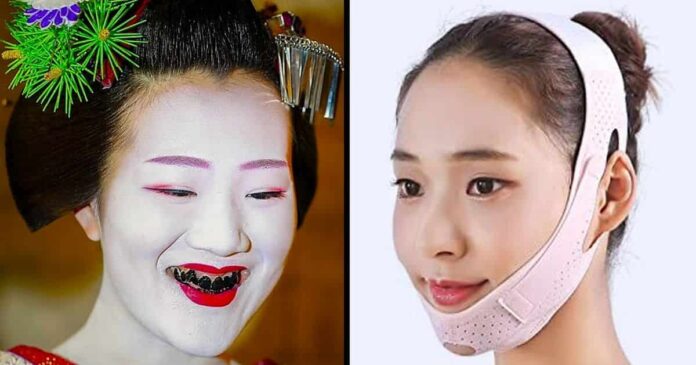
Have you ever considered how nightingale droppings could help you maintain healthy, perfect skin? Or that you might use crushed ants and beetles as lipstick? Or, even better, that shaving the hair off of your forehead’s top portion would make you appear more respectable or wise?
Over the centuries, women engaged in a lot of these and other customs. And even though we may not be aware of it, some of them are still in use today.
We chose the wackiest, weirdest things that women have had to endure in order to conform to beauty standards. One regrettable custom originated in Ancient Egypt and is still practised today. We’ll let you make your own judgments on the subject!
1. Ancient beetle-based cosmetics were widely used, and certain lipsticks may still include insects today.

Ancient Egyptian ladies would crush insects to ensure a stunning and alluring set of red-coloured lips. They would take some sort of pigment from that and put it on their lips. It was Cleopatra’s personal technique (pictured above, played by Elizabeth Taylor in the now-classic hit Cleopatra). To make lip colour, they also combined focus-algin, iodine, and bromine mannite. Some of them, however, were unaware that this combination may be fatal for the one wearing it as lipstick or for the person who gives that person a kiss.
But you’d be mistaken to believe that employing insects to produce colours is a thing of the past. The Dactylopius coccus, a tiny bug found in various cacti in Mexico, the southern United States, and Peru (the world’s first producer and exporter of cochineal), is now used in the cosmetics, food, and beverage sectors. All of these goods actually have a vivid red colour because of this. Thus, it’s very likely that you have consumed, drunk, or worn the dye made from this bug at some point in your life—possibly without even realising it!
2. In Japan, having black teeth meant that you were beautiful, respected, mature, and loyal.
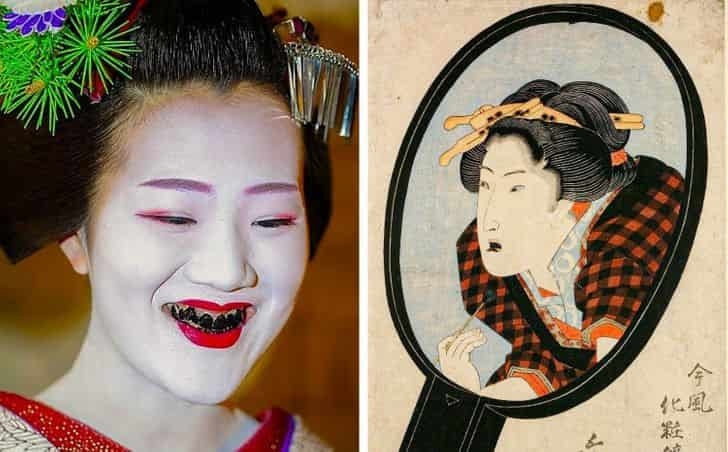
Between the third and sixth centuries, during the Kofun period (250–538 A.D.), traces of blackened teeth have been discovered on bones buried in Japan. The meaning of this Japanese custom, known as ohaguro, has changed over time based on the setting and time it was employed. For instance, it was intended to signify a woman’s coming of age in some situations, her marriage or loyalty in others, or both. It was also thought to be a means of guarding against tooth decay. Many historians dispute the argument that the picture was intended to make married women appear unattractive, which is advanced by a small number of historians.
Iron filings mixed in vinegar with powdered gall or tea were used to make the ink or dye, known as kanemizu. Ohaguro was outlawed by the Japanese government in the late 19th century, and today it is only employed in plays, movies, and a few ceremonial occasions. However, this custom continues to be followed and is still prevalent in several regions of Asia, including India, as well as in Oceania.
3. Nightingale faeces were discovered by Japanese women to improve their skin, and this remedy is being used today.
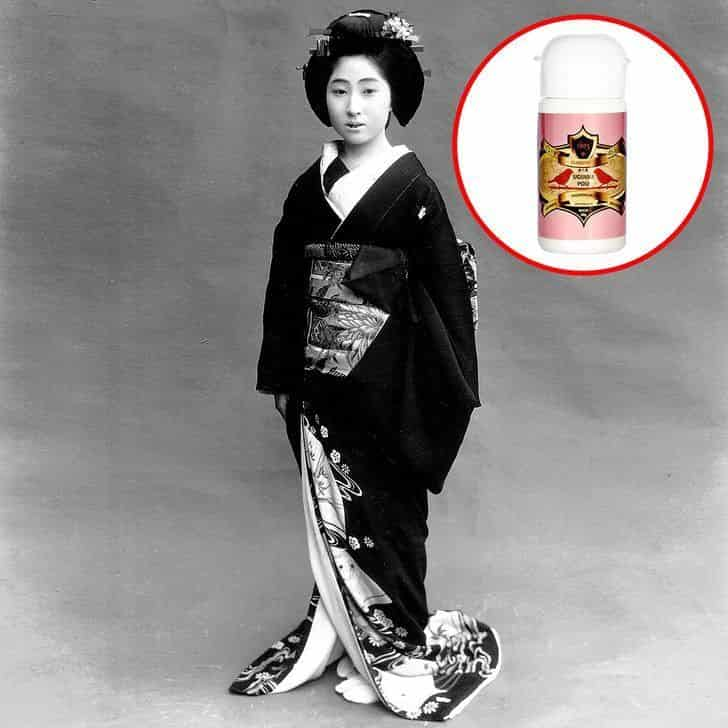
Japanese ladies have employed a mixture of rice bran and a nightingale species’ faeces, known as uguisu in Japan, to lighten their skin since the 17th century. Koreans were known to employ bird droppings to get rid of tough stains on their kimonos, and this practice was adopted by them. After taking off their heavy white makeup, geishas and kabuki theatre performers began utilising this unique substance, known as uguisu no fun, to clean their skin.
This tale may seem a little ridiculous to you, perhaps repulsive. In any event, you should be aware that this behaviour is actually supported by certain scientific theories. Urea, a potent moisturiser found in human urine and sweat as well as bird droppings, is employed widely in the modern cosmetic products business.
There’s more, though. The modern cosmetics business continues to use uguisu no fun as a moisturiser. Today, however, the faeces are completely sterile and free of bacteria. A huge relief! You’ll be pleased to learn that, at least according to gossip publications, Tom Cruise and Victoria Beckham are two celebs who use nightingale droppings as a beauty secret.
4. During Elizabeth I’s reign in the 16th century, having bad teeth—along with white lead cosmetics and shaved eyebrows—was a status symbol.
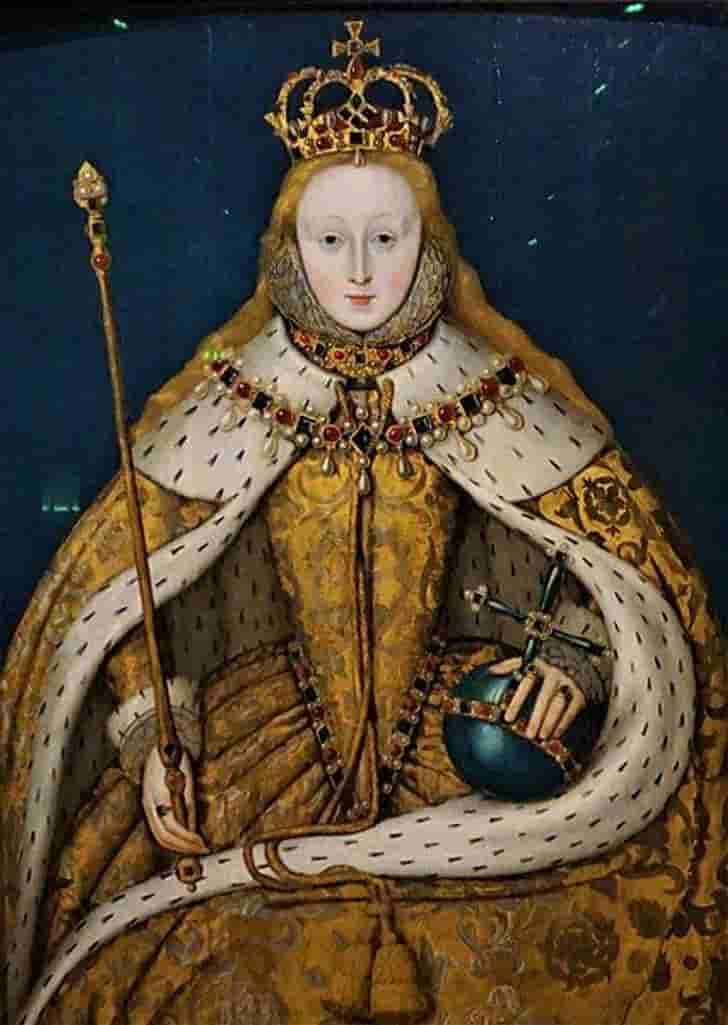
During her reign as monarch of England in the second part of the 16th century, Queen Elizabeth I set many important trends. Of course, none of the trends she started are seen as particularly attractive or healthy by modern standards. Her teeth, to begin with, appeared to be rather worn and decaying due to her love of sweets.
At the time, cane sugar was a novelty in Europe. It was an extremely pricey product that was imported from North Africa. As a result, having dark teeth was a sign of social standing, and some ladies blacked their teeth only to appear to be from the upper classes.
Having browned skin during this queen’s reign was a sign of working-class status. That is why the extremely white makeup that we have all seen in movies was employed to separate the rich from the nobles. However, there was another reason Queen Elizabeth I wore white makeup: she had had the smallpox virus, which left her face with significant scarring.
Due to its lead base, which can result in neurological and other health issues, the cosmetics that was popular at the time is now prohibited. Shaving a portion of the hair created a large forehead, which was a sign of strength and intelligence and completed the traditional appearance of the time.
5. The fact that European Renaissance nobility wore extraordinarily high heels set them apart from other women.
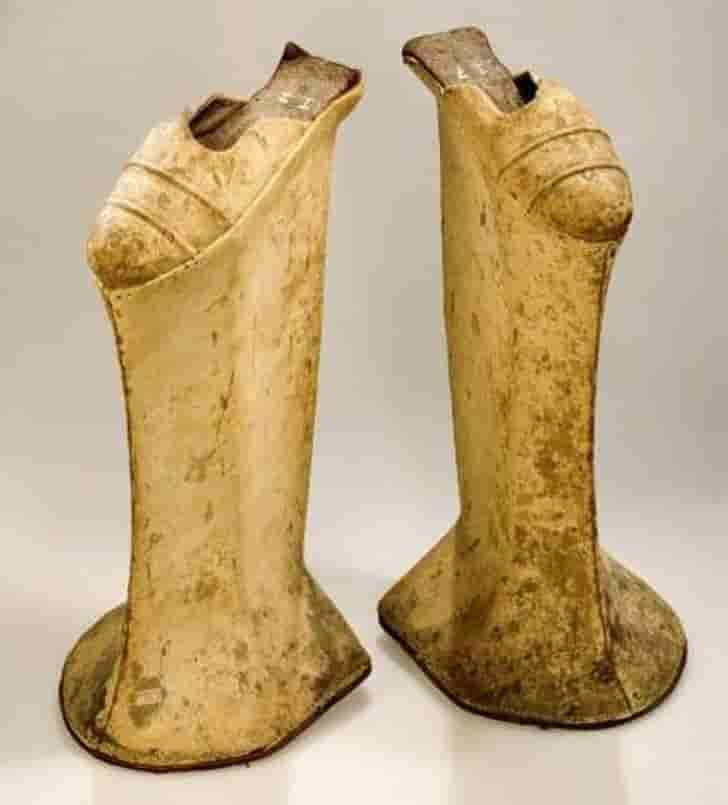
Italian women of the upper classes sought to stand out from the crowd in the 15th and 16th centuries by donning extremely high shoes known as chopines. Another argument for the adoption of such an odd design trend is that the platforms kept the lords’ gowns from dragging as they walked down the city’s filthy sidewalks and floors.
Venice was the birthplace of the chopines movement, which swiftly spread to other nations in Europe including France and Spain. Ladies who wore chopines were always accompanied by 2 attendants to practically support them at shoulder level so that they could walk with at least some balance and stability.
6. In the 18th century, enormous wigs secured with lard were a really exquisite ornament (and mice also adored them!).

Girls had to wear enormous wigs in order to appear attractive in the French court of the 18th century. They would have them embellished with various flowers, gems, ribbons, and even plush animals. A nice illustration of that trend may be seen in the picture of the Princesse de Lamballe (above), a close friend and confidante of Queen consort Marie Antoinette.
These wigs were the creations of talented experts who used animal lard to join the synthetic hair to the natural hair. It was typical for women to attract rats and other animals because they used to wear wigs a lot of the time, especially when sleeping.
7. In the 19th century, clothing and other objects were dyed with a pigment whose formula contained poison.
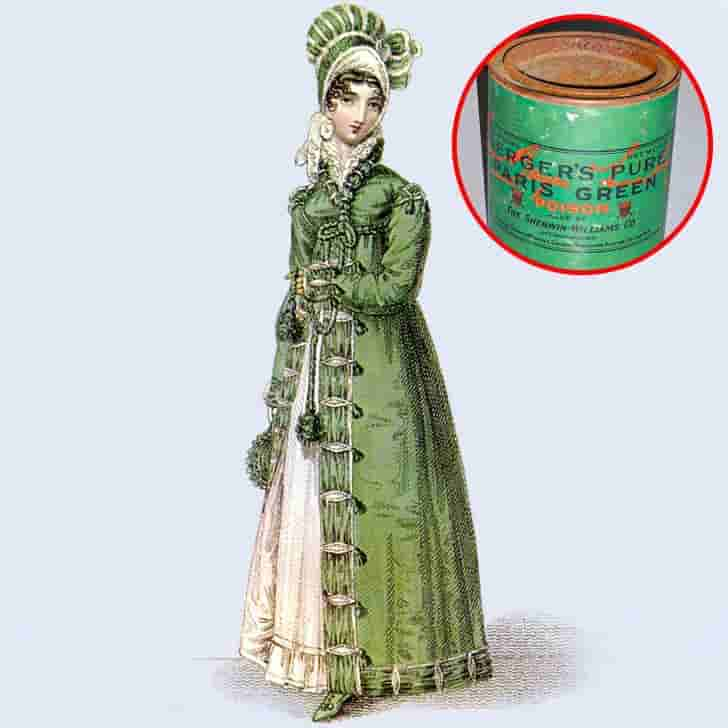
The phrase “fashion victim” had a literal connotation in 19th-century Europe. It became quite popular to dye fabrics, ribbons, fake flowers, hats, wallpaper, and other everyday items in a particular shade of green known as Paris green or Scheele green. However, this colour was produced using exceedingly hazardous arsenic. Several nations outlawed its use in clothing and other manufacturing before the century was through. In fact, it is still employed as a pesticide today.
8. Wealthy women literally understood the term “porcelain skin” (they also emulated the limp of the Queen of England!).
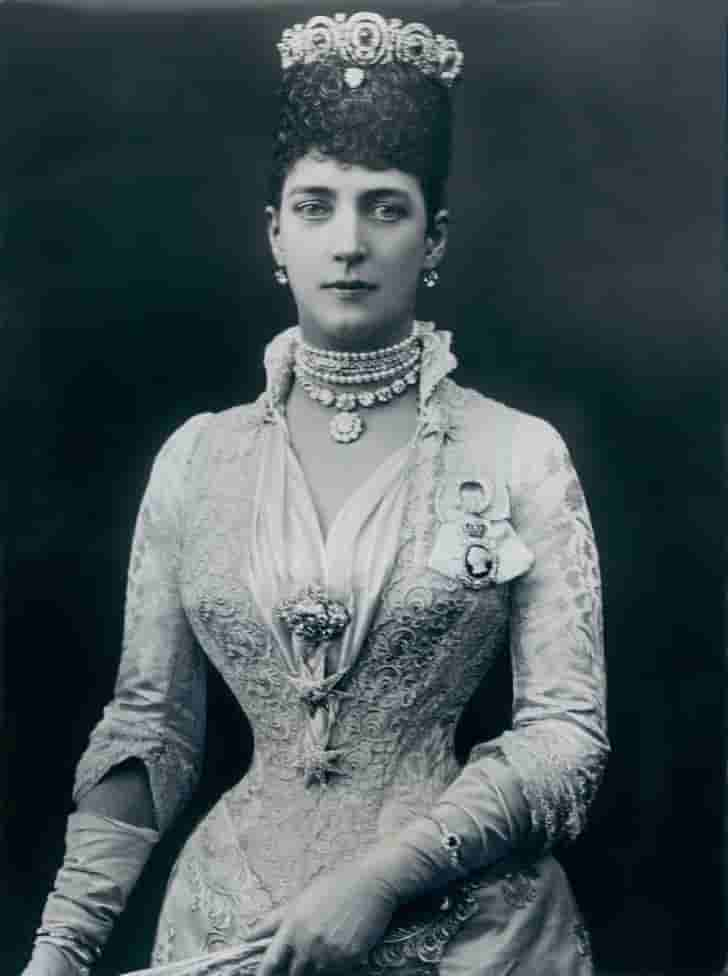
Perhaps your grandmother or another senior family member mentioned that “so-and-so has porcelain skin.” Well, there was a time when the word had a literal meaning, which was in the late 19th and early 20th centuries.
Princess Alexandra of Denmark, afterwards known as Queen Consort of England, is thought to have been adept in the enamelling technique, which entailed applying a poisonous white paste made of zinc or lead to the skin. After the paste had dried, they would paint it on to add details like pinkish faces, tiny veins, and other features that, in their opinion, made their makeup appear more genuine.
Depending on the tactics employed, the effect can persist for a long period. Otherwise, it might potentially be periodically refreshed. On the arms and neck, makeup was applied using the same method. You could undergo enamelling in specialised salons in New York that lasted for two days to six months.
Another interesting detail about Queen Alexandra is that she had the rheumatic disease in 1867, which left her with a lifelong limp. English women at that time started to imitate her crooked steps. To make their gait appear more genuine, some women even had shoes created with various heel heights.
9. The chin reducer promised to restore lost youth in a few hours (today, this marketing technique still works).
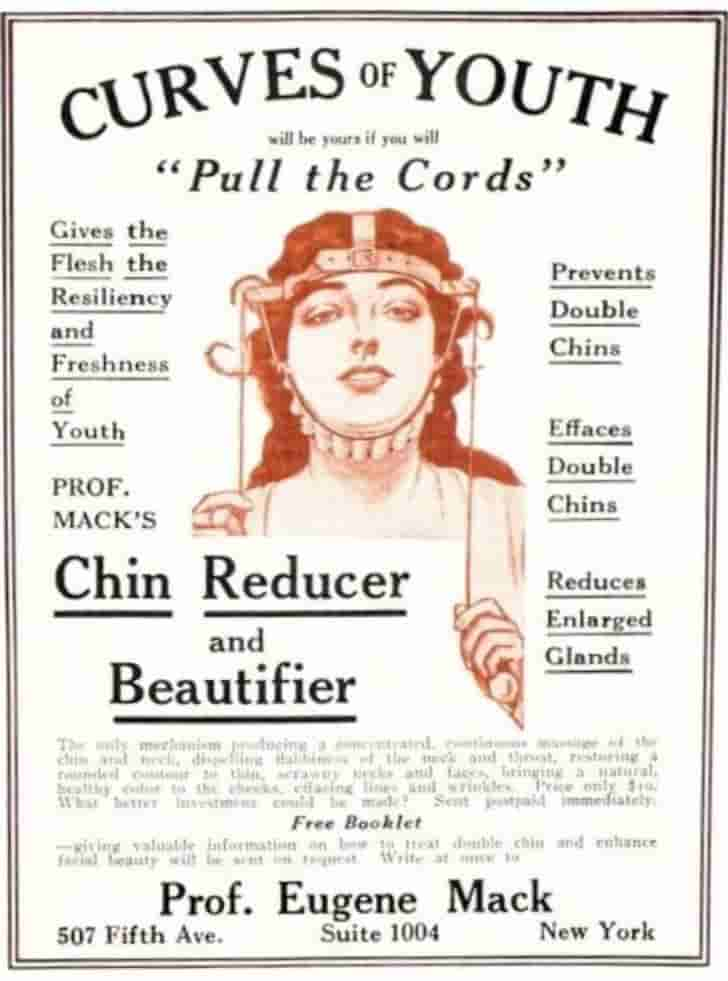
A New York businessman advertised a chin reducer in the 19th century, although it more closely resembled a tool for self-punishment. Even if such were the truth, it nevertheless gained a lot of popularity. It made the claim that it would eliminate double chins and restore “the freshness of youth” in women. If this device was genuinely just a bizarre innovation from the past, it would make for a funny anecdote to share at a gathering. Sadly, this simply isn’t the case. There are contemporary iterations of the chin reducer, and you can get them from a variety of online retailers (see the picture below).
Could it possibly succeed? In fact, the double chin is diminished while utilising this device, according to Pascale Day, a contributor to the English beauty website So Feminine. However, the effects only last a few days. It’s something you do to get ready for a night out and isn’t meant to last, she wrote.

10. Early in the 20th century, skirts that “bound” the legs and made it nearly hard to walk were the current fashion fad.
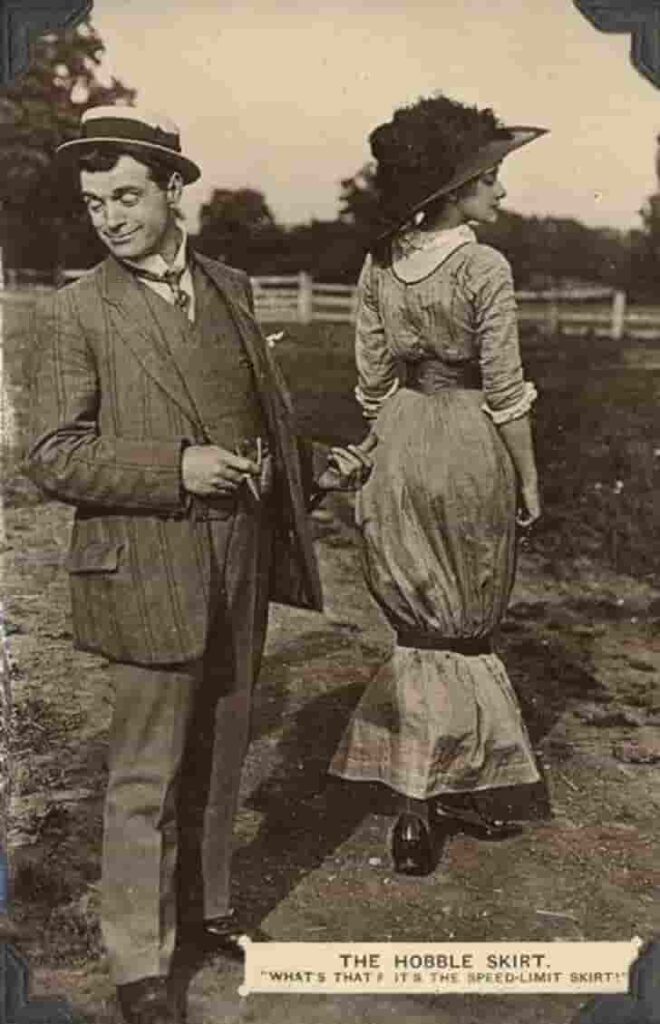
In order for ladies in the past to feel beautiful and graceful while wearing a skirt, tying and tightening were two essential requirements. That may be the reason why the hobble skirt was popular from 1908 to 1914. These skirts required ladies to walk with extremely small steps because the bottom of them resembled a sort of tube. They may have gotten their name from that.
This peculiar fashion craze, according to French designer Paul Poiret, was his idea. He even asserted that he was the one who popularised it in America. For instance, streetcars in New York and Los Angeles were modified to allow ladies to board while donning the “baby step skirts.” A man can be seen on the postcard below making fun of this outfit while laughing: “It’s a skirt with a speed limit.”



